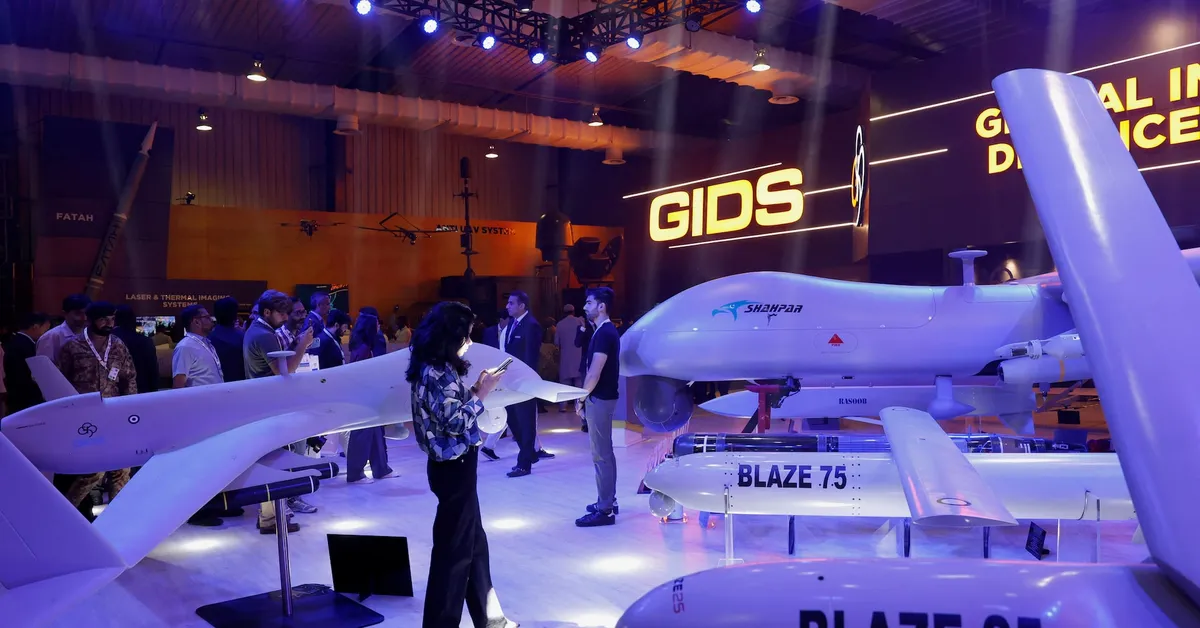
On May 8, shortly after 8:00 PM, the night sky over Jammu, a city in northern India, erupted with red flares as the Indian air-defense systems engaged drones originating from Pakistan. This dramatic incident marked a significant escalation in the ongoing military tensions between India and Pakistan, as it was the first time both nations employed unmanned aerial vehicles (UAVs) on such a large scale against each other. According to reports from Reuters, the fighting, which lasted for four days, has set the stage for a burgeoning arms race in drone technology between these two nuclear-armed neighbors.
The hostilities were eventually halted when the United States intervened to broker a ceasefire. However, both India and Pakistan, which collectively allocated over $96 billion to defense spending last year, are now increasingly focused on enhancing their drone capabilities. Interviews with security officials, industry experts, and analysts reveal a consensus that both nations are likely to ramp up their use of UAVs. This shift is largely due to the effectiveness of small-scale drone attacks, which can strike critical targets while minimizing the risk to personnel and avoiding large-scale military escalation.
India is gearing up for significant investments in its domestic drone industry, with plans to allocate as much as $470 million on UAVs over the next 12 to 24 months, a figure that is three times higher than pre-conflict spending. This forecast, previously unreported, aligns with India's recent approval of approximately $4.6 billion in emergency military procurement funds. Officials from the Indian military have indicated that a portion of these funds will be directed towards combat and surveillance drones.
Meanwhile, the Pakistan Air Force is actively seeking to enhance its UAV capabilities to reduce the risks associated with deploying high-end aircraft. While both nations utilized advanced generation 4.5 fighter jets during the recent clashes, Pakistan's fleet is limited to about 20 high-end Chinese-made J-10 fighters, in stark contrast to India's three dozen Rafale jets. To bolster its drone capabilities, Pakistan is likely to deepen its collaborations with China and Turkey, focusing on advancing local drone research and production. Reports indicate that a partnership between Pakistan's National Aerospace Science and Technology Park and the Turkish defense contractor Baykar aims to locally assemble the YIHA-III drone.
The recent clashes were the most intense between India and Pakistan in this century and were ignited by a militant attack in Kashmir on April 22, which resulted in 26 fatalities, primarily among Indian tourists. India accused Pakistan of harboring the terrorists responsible, prompting Prime Minister Narendra Modi to promise retaliation. The situation escalated further on May 7 when India conducted airstrikes targeting what it identified as terrorist infrastructure in Pakistan. In response, Pakistan launched a significant number of drones to test India’s air defenses along a 1,700-kilometer (772-mile) front, deploying between 300 to 400 drones across 36 locations.
Pakistan utilized a mix of Turkish-origin YIHA-III and Asisguard Songar drones, alongside the domestically produced Shahpar-II UAV. While a Pakistani source denied that a substantial number of its drones were downed during the May 8 incident, Indian officials reported minimal damage from the drone raid. Interestingly, India's use of anti-aircraft guns, not initially designed for counter-drone warfare, proved unexpectedly effective, significantly exceeding expectations of military analysts.
Both nations have demonstrated the ability to employ UAVs effectively, with India reportedly achieving successful strikes on strategic infrastructure within Pakistan, while Pakistan claimed to have targeted Indian defense facilities. Political scientist Walter Ladwig III from King's College London notes that drone strikes enable both countries to exert military pressure without inciting immediate large-scale conflict. UAVs serve as tools for leaders to exhibit resolve and manage domestic perceptions while safeguarding personnel and high-value assets.
Despite the advantages, the use of UAVs is not without its risks. These skirmishes could lead to unintended escalation, particularly if drones are deployed in contested or densely populated regions where manned aircraft might have previously been avoided. As both nations continue to refine their drone capabilities, the implications for regional security are profound.
Despite the challenges presented by drone warfare, both India and Pakistan are doubling down on their UAV technologies. Experts emphasize that drones represent relatively inexpensive technology that, while lacking the immediate impact of missiles or fighter jets, still conveys a strong sense of military capability. India's defense planners are likely to focus on expanding the domestic development of loitering munitions UAVs. Firms like NewSpace are ramping up research and development for these drones, which are designed to evade detection while delivering precise strikes.
However, India's drone program faces vulnerabilities, particularly its reliance on components sourced from China, a key military partner for Pakistan. The dependency on Chinese-made magnets and lithium for UAV batteries poses a significant risk, especially amid growing geopolitical tensions. Moreover, experts warn that China’s ability to restrict the supply of drone components could impact India’s military readiness, as witnessed in other global conflicts.
In conclusion, the recent clashes between India and Pakistan highlight the pivotal role of drone technology in modern warfare. As both nations invest heavily in UAV capabilities, the dynamics of their military engagements are likely to evolve, presenting new challenges and opportunities for regional stability.